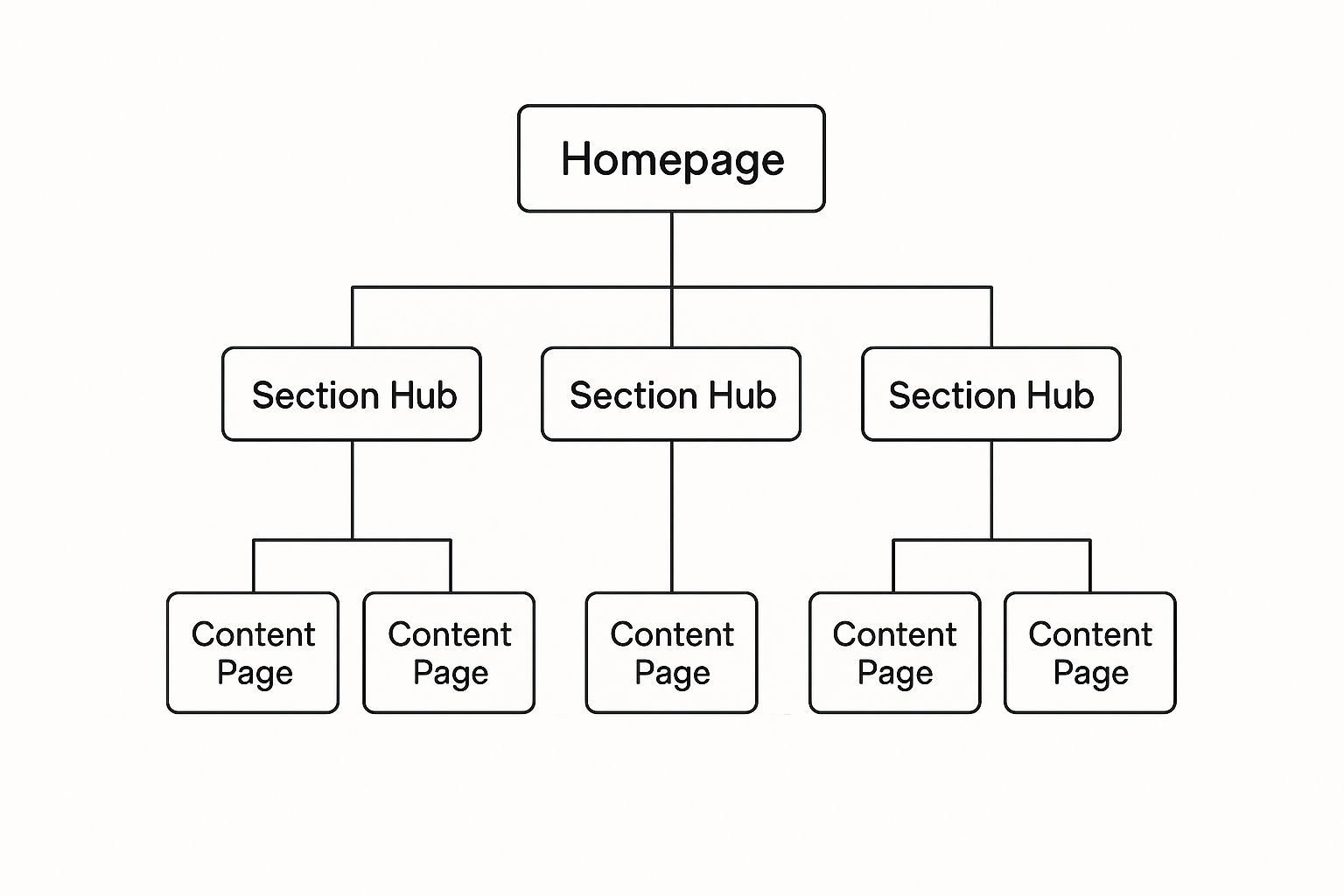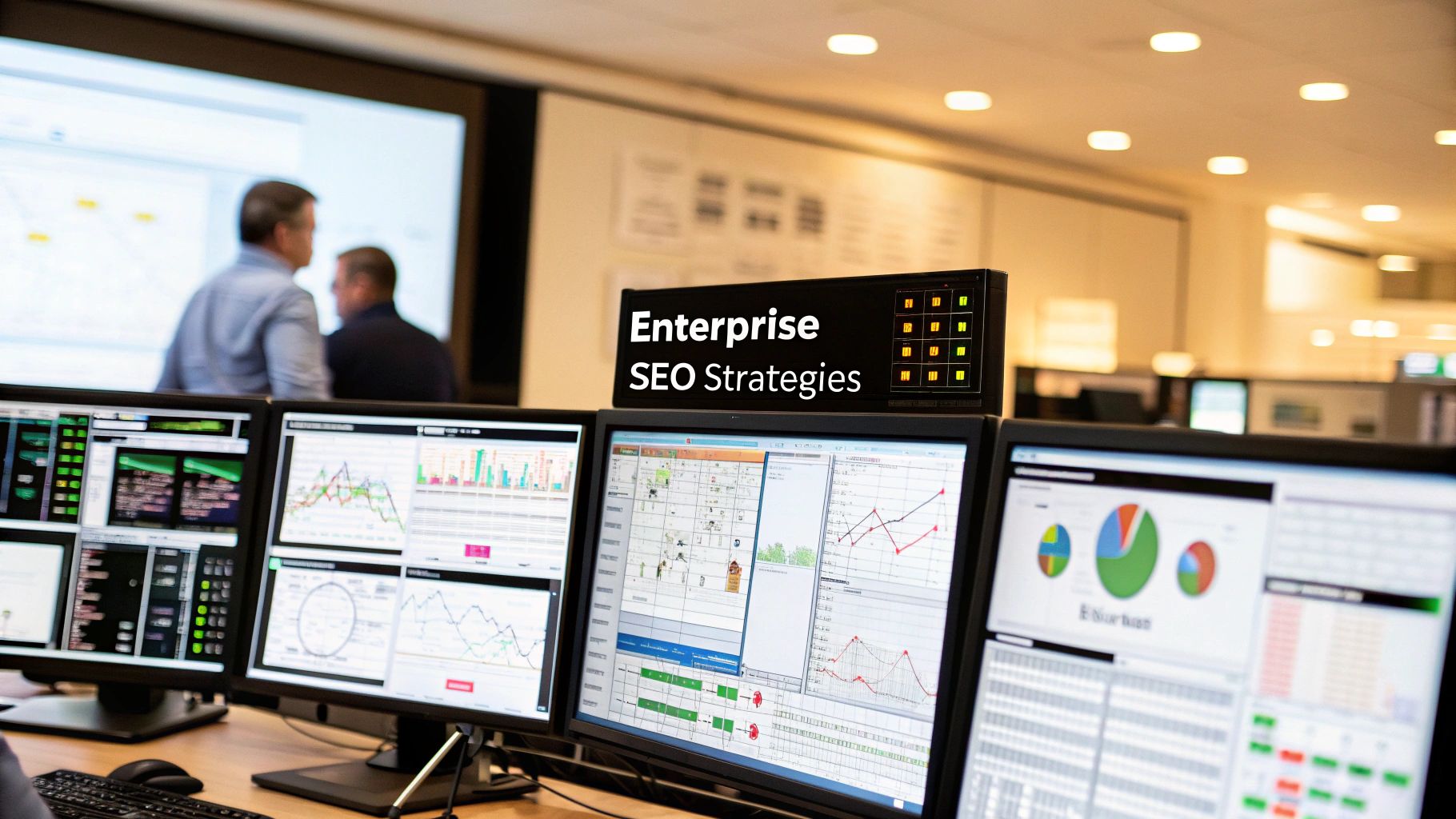When you’re running SEO for a site with a few hundred pages, you’re steering a speedboat. It’s nimble, you can change direction fast, and a small crew gets the job done.
But enterprise SEO? That’s like commanding a global shipping fleet. Every turn requires careful coordination across multiple departments, sophisticated tech, and a rock-solid, long-term strategy to keep every vessel moving in the right direction. It's a completely different ballgame.
Beyond Standard SEO: What Makes It Different?

The difference isn't just the page count—it's the crushing complexity that comes with it. A small business might zero in on a handful of high-value keywords. An enterprise has to fight for thousands of terms across different product lines, countries, and languages, all at the same time.
The Challenge of Scale
The single biggest thing that separates enterprise SEO from everything else is scale.
When you’re dealing with a sprawling digital ecosystem, manual optimization is a fantasy. Simple tasks like tweaking meta descriptions or adding a few internal links become monumental challenges. A single technical glitch on a small blog is an easy fix; on an enterprise site, it can vaporize millions in revenue overnight.
This forces a total shift in mindset. You stop thinking about one-off tactics and start building repeatable, efficient systems that can operate at a massive scale.
Enterprise SEO moves beyond just chasing rankings to become a core business function. It’s about building a predictable engine for organic growth that’s deeply woven into product, engineering, and marketing to hit shared goals.
The Three Pillars of Enterprise SEO
Because of this intense complexity, a successful enterprise strategy absolutely must be built on three pillars. These aren’t just nice-to-haves; they’re what keep the entire operation from collapsing under its own weight.
- Scalable Technical Integrity: This is all about keeping a massive website technically sound. Think optimizing crawl budget so search engines don't get lost, managing internationalization with hreflang tags across dozens of domains, and fighting off the nightmare of duplicate content on millions of pages.
- Systematized Content Operations: You're not just writing articles; you're building a content engine. This means establishing topical authority with hub-and-spoke models and creating clear governance so a decentralized army of creators can produce consistent, high-quality work.
- Robust Governance and Measurement: This is the framework that embeds SEO best practices across the entire organization. It involves defining who owns what, establishing a center of excellence, and tying SEO performance directly to the KPIs that the C-suite actually cares about, like revenue and market share.
It’s clear that enterprise SEO is a different beast entirely, which is why as of 2025, a whopping 62% of B2B marketers have made it a core part of their strategy. It’s not just a marketing channel anymore; it’s a critical component of corporate growth. For a deeper dive, check out more insights on enterprise SEO for B2B brands on RevvGrowth.com.
Building a Website Architecture That Scales
Think of your website's architecture as the blueprint for a skyscraper. If the foundation is shaky or the floor plan makes no sense, every level you build on top is just asking for trouble. For an enterprise site with thousands—or even millions—of pages, a weak architecture doesn't just create problems. It guarantees failure.
A scalable site architecture is a logical, hierarchical structure that makes sense to both people and search engine crawlers. It’s the difference between a perfectly organized library where you can find any book in seconds, and a chaotic warehouse where valuable information is lost for good.
Without a solid plan, large sites quickly devolve into a tangled mess of technical debt, orphaned pages, and keyword cannibalization. It becomes nearly impossible for search engines to figure out what your most important content is, let alone rank it.
Designing a Logical Hierarchy
The heart of a scalable architecture is a clean hierarchy. This isn't just about looks; it's about creating predictable paths for users and crawlers to follow. The gold standard is a flat structure, where most pages are accessible within just a few clicks from the homepage.
This visual shows how a simple yet powerful hierarchy works, with the homepage at the top, followed by main section hubs, and finally, individual content pages.

As the diagram shows, authority flows logically from high-level pages down to more specific topics. This setup keeps the structure clean and crawlable, avoiding those deep, confusing navigation paths that trap search engine bots and send users running.
When you're designing an architecture that can handle enterprise-level demands, it's worth exploring the top open-source headless CMS platforms. These systems are engineered for the kind of flexibility and performance that massive sites require.
Mastering Internal Linking at Scale
Let's be real: manually adding internal links across a million-page site is a non-starter. Your architecture needs to support automated, rule-based internal linking instead. Think of these links as the circulatory system of your website, pushing "link equity" (or authority) from powerful pages to newer or deeper ones.
A smart internal linking strategy doesn't just connect pages. It strategically channels authority to your most valuable content, signaling to Google which pages matter most for your business goals.
To pull this off, you need to build automated systems that:
- Prioritize Hub Pages: Make sure your main category or "hub" pages get the most internal links, cementing their authority on a given topic.
- Use Contextual Anchors: Your links should use descriptive anchor text that tells crawlers what the destination page is about. No more "click here."
- Audit Regularly: Use tools to hunt down and fix broken links or redirect chains that bleed authority and create a terrible user experience.
Conquering Duplicate Content and Internationalization
Duplicate content is one of the biggest silent killers of an enterprise site's health. It pops up everywhere—from faceted navigation and tracking parameters to having multiple page versions for different countries. This is where technical precision is everything.
Canonical tags (rel="canonical") are your first line of defense. They act like a signpost, telling search engines, "Hey, out of all these similar-looking pages, this one is the master copy you should index." Implementing these at scale stops Google from getting confused and splitting your ranking signals across a dozen different URLs.
For global companies, hreflang tags are just as crucial. These tags tell Google which language and regional version of a page to show to a user in a specific location. A correctly implemented hreflang strategy ensures that someone in Germany sees the German version (de-de) of your site, while a user in Mexico sees the Spanish version (es-mx). It prevents a bad user experience and some seriously messy ranking problems.
Developing Your Scalable Content and Keyword Engine

For a massive company, content isn't a series of one-off projects. That’s a surefire way to waste time and money. Instead, think of it as a powerful, interconnected engine built to systematically drive growth across every product line, business unit, and global market you touch.
The goal is to build something that scales. Imagine it like a city's power grid. You aren't just flipping on one light switch at a time. You're creating a vast, reliable network that delivers consistent energy—in this case, traffic and authority—to every corner of your digital footprint. This is a non-negotiable pillar of any serious enterprise SEO strategy.
Establishing Topical Authority with the Hub and Spoke Model
The foundation of this content engine is the hub and spoke model, often called topic clustering. It’s designed to prove your deep expertise to search engines, helping you own entire categories, not just a handful of keywords.
The structure is brilliantly simple:
- The Hub Page: This is your broad, comprehensive pillar page covering a core topic, like "Cloud Security Solutions." It's the central authority, linking out to all the related spoke pages.
- The Spoke Pages: These are detailed articles that go deep on specific subtopics, such as "Data Encryption Best Practices" or "Cloud Compliance Standards." Crucially, every spoke page links back to the main hub.
This tight, interconnected web signals to Google that you know your stuff. It also creates a logical user journey, improves your internal linking, and keeps visitors on your site longer. Get this right, and you'll see a lift in rankings across the entire cluster of pages.
Leveraging Programmatic SEO for Massive Scale
The hub and spoke model is perfect for building authority. But what happens when you need thousands of hyper-specific pages for different products, locations, or use cases? You can’t write them all by hand. It’s impossible.
This is where programmatic SEO changes the game.
Programmatic SEO uses templates and data to automatically generate thousands of unique, optimized pages. Think of a real estate giant creating a specific landing page for every single home model in every city it operates in. That's programmatic SEO in action.
By combining a structured data source with a well-designed page template, you can target an enormous number of long-tail keywords that would be impossible to capture with manual content creation alone. This approach turns your data into a powerful traffic-generating asset.
This isn't about churning out low-quality spam. The magic happens when you start with a robust dataset and create high-quality templates that deliver real value. For example, a travel site could programmatically create pages for "family-friendly hotels in [City Name] with a pool" by pulling from its hotel database.
When deciding between manual and programmatic approaches, it's not an either/or situation. Most enterprises need both. Here's a quick comparison to help you see where each fits best.
Comparing Manual vs Programmatic Content Approaches
Ultimately, a winning strategy blends the deep authority of manually crafted hubs with the immense reach of programmatically generated spokes.
Creating a Robust Content Governance Framework
With so many moving parts—decentralized teams, programmatic pages, and multiple business units—things can get chaotic fast. Without rules, you risk brand inconsistency and quality control nightmares. This is why a strong content governance framework is an absolute must.
This framework is your rulebook for the entire content operation. It's much more than a style guide; it's the system that defines workflows, roles, and standards. Developing a clear content marketing strategy framework is the only way to ensure every piece of content—whether written by a human or a machine—actually supports your business goals.
Your governance plan should lock down a few key areas:
- Clear Workflows: Map out every single step, from ideation and keyword research to creation, review, approval, publishing, and eventual refreshing. No ambiguity.
- Defined Roles and Responsibilities: Everyone needs to know exactly what they own. Who signs off on legal compliance? Who is responsible for SEO optimization?
- Comprehensive Style Guides: Document everything. Brand voice, tone, formatting rules, and SEO best practices must be crystal clear to ensure consistency.
- Quality Assurance Checklists: Give reviewers a concrete checklist to ensure every piece of content meets your standards before it ever sees the light of day.
By putting this engine in place, you shift from reactive, one-off content creation to a proactive, scalable system that consistently builds authority and drives real business results.
Integrating AI to Supercharge Your SEO Workflow
https://www.youtube.com/embed/PmKPtCUZlCE
Let's be real. Manually managing SEO for a website with millions of pages isn't just hard—it's impossible. This is where AI stops being a buzzword and becomes your essential co-pilot. For modern enterprise SEO teams, it's the only way to handle the sheer scale of the job.
Think of AI as a force multiplier. It doesn't replace skilled SEO professionals. Instead, it automates the repetitive, soul-crushing tasks that eat up their time. This frees up your team to focus on what actually drives growth: high-level strategy, creative problem-solving, and building relationships across the company.
Automating Critical SEO Tasks with Precision
AI-powered tools can execute core SEO functions with a speed and accuracy that no human could ever match. These automations are the bedrock of any enterprise SEO strategy that hopes to scale.
Here are a few key areas where AI delivers immediate value:
- Keyword Clustering: Instead of spending days trying to group thousands of keywords, AI algorithms can map out semantic relationships and user intent in minutes, creating perfectly structured topic clusters.
- Internal Link Analysis: AI can crawl your entire site, instantly spot orphaned pages, and suggest the best internal linking opportunities to spread authority and improve how search engines see your site.
- Large-Scale Technical Audits: Imagine continuously monitoring millions of pages for broken links, redirect chains, or wonky canonical tags. AI tools do this in the background, flagging problems in real-time before they tank your performance.
The shift is already happening. A whopping 67% of SEO experts say the biggest win from generative AI is automating all the mundane work. It's not just about saving time, either—65% of businesses reported better SEO results after bringing AI into the mix.
With 75% of marketers using AI to slash time spent on manual tasks, it’s no surprise that 82% of enterprise SEO specialists are planning to invest even more in it.
Balancing Generative AI with Human Oversight
Generative AI has thrown the doors wide open for content ideation and creation, but you can't just set it and forget it. While it's great for drafting content briefs or brainstorming topics, it can't replicate your brand's voice, deep expertise, or strategic thinking on its own.
The winning model is 'human-plus-AI.' Technology handles the heavy lifting, while human experts add the critical layers of strategy, quality control, and brand alignment.
This means using AI as a starting point, not the final product. To get the most out of it, you need to know how to refine and polish what the machine gives you. This is a critical skill, and you can learn more about it in this Humanizer for AI SEO Content: Your Essential Guide.
Using Predictive Analytics to Forecast Impact
Beyond just automation, AI is changing how we forecast results. Predictive analytics models can chew through historical data, market trends, and competitor performance to estimate the real-world impact of your SEO initiatives.
This is a game-changer for getting buy-in. You can finally build a strong business case for SEO investments by answering questions like, "What's the likely traffic lift if we optimize this entire category of pages?"
By moving from just analyzing what happened to forecasting what will happen, you can prioritize the projects that deliver the biggest returns. It's how you align your SEO strategy directly with the company's bottom line. For a deeper dive into this, check out our guide on AI search engine optimization.
Mastering Technical SEO and Link Acquisition

Technical SEO on an enterprise site is a lot like being the chief engineer on a starship. It’s a high-stakes gig where a tiny mistake—a rogue canonical tag or a slow script multiplied across thousands of pages—can send your visibility and revenue into a nosedive. The scale alone turns everyday optimizations into massive engineering puzzles.
We’re moving beyond the basics here. The goal is to build a superhighway for search crawlers so they can discover, understand, and index your most important content without hitting a single red light.
Optimizing Your Crawl Budget
Every big website gets a finite crawl budget—think of it as Google’s allowance for crawling your pages. With millions of URLs in the mix, you can't afford to let it get wasted on dead-end pages, redirect loops, or URLs cluttered with tracking parameters.
Smart crawl budget management is about playing bouncer. You have to be strict about who gets in.
- Strategic Disallows: Use your
robots.txtfile to block crawlers from the junk drawers of your site, like internal search results or user profiles. - Parameter Handling: Tell Google which URL parameters to ignore so it doesn’t see a dozen duplicates of the same page.
- Sitemap Hygiene: Keep your XML sitemaps squeaky clean and up-to-date. They should only point to the valuable, canonical URLs you actually want indexed.
This forces Google to spend its limited time on the pages that actually make you money, instead of getting lost in a digital maze.
Rendering JavaScript and Page Speed at Scale
Most modern enterprise sites are powered by JavaScript, which creates those slick, dynamic experiences users love. But for search crawlers, it can be a total nightmare. If not handled correctly, JavaScript can render your content completely invisible to Google.
The solution is dynamic rendering. It’s a clever setup where your server detects when a search bot is visiting and hands it a simple, fully rendered HTML version of the page. Meanwhile, human users get the full, interactive JavaScript experience. It’s the best of both worlds.
At the same time, page speed is completely non-negotiable. One study found that a tiny 0.1-second improvement in mobile site speed can lift conversions by over 8%. At enterprise scale, that’s huge. Achieving this requires:
- Content Delivery Networks (CDNs) to serve files from servers physically closer to your users.
- Image Compression and Modern Formats like WebP to slash file sizes without sacrificing quality.
- Lazy Loading for images and videos, so they only load when a user actually scrolls to them.
Think of a slow website as a store with a perpetually long line. It doesn't matter how great the products are inside; most people will just give up and leave before they even get through the door. Speed isn't a perk; it's a prerequisite for success.
Link Acquisition for Market Authority
A technically perfect website is the foundation, but authority is what gets you to the top of the rankings. For enterprises, link acquisition isn't about chasing random backlinks one by one. It’s about running scalable campaigns that build real trust and cement your brand as the go-to leader in your industry. For a closer look at this in practice, our guide to SEO for SaaS companies is packed with good examples.
But let’s be honest: building links at this level is incredibly tough. You're fighting against high costs—the average backlink is now $361.44—and the fact that over 66.5% of all backlinks are broken. To get around this, you have to build systems that generate links naturally and at scale. You can learn more about these challenges and other SEO statistics on DigitalSilk.com.
Here are a few strategies that actually work:
- Digital PR Campaigns: Publish original data, proprietary reports, or compelling stories that journalists and industry blogs want to write about. A single great campaign can land you dozens of high-authority links.
- Create Linkable Assets: Build something genuinely useful, like a free tool, a calculator, or an exhaustive guide that solves a real problem for your audience. These become magnets for links over time.
- Strategic Partnerships: Team up with non-competing companies in your space for co-branded content, webinars, or joint research. It’s a win-win that exposes your brand to new audiences and creates natural linking opportunities.
Combine flawless technical execution with a powerful link-building engine, and you create an unstoppable force—one that doesn't just rank, but completely owns the conversation in your market.
Measuring Success with a Governance Framework
In a big company, if you can’t measure it, you can't manage it. Simple as that.
Proving the value of a complex enterprise SEO strategy means you have to stop talking about vanity metrics like keyword rankings. The only thing that matters is what the business values, and that means connecting every single SEO action directly to the bottom line.
You have to shift the conversation from, "Hey, we ranked for this keyword!" to "Organic search drove this much revenue last quarter." If you can't make that leap, your SEO program will always be fighting for scraps of budget and buy-in.
Focusing on Business-Critical KPIs
To get leadership to actually pay attention, you have to speak their language. Marketers get excited about a traffic spike, but the C-suite wants to see tangible business outcomes. Cold, hard numbers.
Your primary key performance indicators (KPIs) need to be tied directly to financial goals.
- Organic Revenue: This is the gold standard. It tracks the actual sales and revenue generated from visitors who found you through organic search. No fluff.
- Qualified Lead Generation: For B2B, this is your money metric. How many MQLs or SQLs came from organic traffic? This shows SEO is feeding the sales pipeline.
- Share of Voice (SOV): This one is about market dominance. It shows your brand’s visibility in search results for your most important topics compared to your top competitors. It’s how you prove you own the conversation.
Building dashboards that make these KPIs impossible to ignore is a must. Tools like Looker Studio are great for pulling data from all over the place into real-time reports that anyone from a marketing manager to the CEO can understand at a glance.
Establishing a Strong SEO Governance Framework
Measurement proves your worth, but governance is what makes that value repeatable and scalable. An SEO governance framework is just a fancy term for the set of rules, roles, and processes that bake best practices into your company's DNA. It's what stops SEO from being an afterthought tacked on at the end.
SEO governance is the system that turns your strategy from a bunch of isolated projects into a consistent, company-wide capability. It defines who is responsible for what, making sure every team—from content to dev—is pulling in the same direction.
A solid framework usually leads to creating a center of excellence—a core group of SEO experts who guide and empower other teams instead of trying to do everything themselves.
Defining Clear Roles and Responsibilities
Without clear ownership, critical SEO tasks just fall through the cracks. Someone thought someone else was handling it. A huge part of governance is spelling out exactly who is responsible for each piece of the puzzle.
For example:
- The Content Team: They own keyword integration, on-page optimization, and internal linking inside their articles. It's part of their workflow, not a favor to the SEO team.
- The Development Team: They're on the hook for technical SEO. That means things like page speed optimizations, schema markup, and managing the crawl budget.
- The Product Team: They need to make sure new product pages or features are built with SEO in mind from day one, not as a cleanup job six months after launch.
When you create this kind of clarity, you kill the bottlenecks and build a culture of shared accountability. This structured approach is the only way to make sure your enterprise SEO strategies are rolled out correctly and consistently, driving the kind of success that lasts.
Frequently Asked Questions
Look, diving into enterprise SEO brings up a ton of questions. Let's cut through the noise and tackle the big ones.
What’s the Biggest Difference Between Regular SEO and Enterprise SEO?
The simplest answer is scale.
Think of it this way: regular SEO is like meticulously tuning a single high-performance race car. Enterprise SEO is like managing the entire logistics, engineering, and race strategy for a Formula 1 team with a fleet of cars, dozens of engineers, and a global race schedule.
You're not just tweaking a few pages. You're dealing with websites that have thousands, sometimes millions, of pages. This demands strategies built for massive scale, smart automation, and getting different departments—from IT to marketing to legal—to actually work together. Standard SEO might zero in on a handful of money-making pages, but the enterprise game is about creating systems that lift the entire digital footprint.
How Do You Measure the ROI of an Enterprise SEO Strategy?
This is where the conversation gets serious. Measuring the return on investment (ROI) for enterprise SEO goes way beyond just bragging about keyword rankings. Success has to be tied directly to real business goals.
Forget vanity metrics. Enterprise SEO measures its impact with the same KPIs the C-suite cares about. The conversation shifts from "Hey, we're ranking!" to "Here's how much revenue we drove this quarter."
We’re talking about metrics that matter:
- Organic Revenue Contribution: How much actual cash did we generate from organic search? This is the bottom line.
- Reduced PPC Spend: How much money did we save by ranking organically for keywords we used to pay for? Every dollar saved is a win.
- Share of Voice: How visible is our brand compared to our top competitors for the keywords that define our market? Are we dominating the conversation?
- Marketing Qualified Leads (MQLs): How many real, high-quality leads did we hand over to the sales team from our organic efforts?
Can Small Businesses Use Enterprise SEO Strategies?
Absolutely. A small business doesn't need to splurge on the expensive enterprise tool stack or build out complex, multi-departmental workflows. But adopting the mindset? That’s a game-changer.
By thinking like an enterprise from day one, a smaller company builds a foundation that won't crumble under the weight of future growth. It means creating a scalable site architecture from the get-go, establishing a clear content governance plan to keep quality high, and treating technical health as a non-negotiable.
It’s about building it right the first time, so you’re not trying to fix a broken foundation when you’re finally ready to scale.
Ready to make your SaaS brand a recognized authority in your niche? PimpMySaaS helps B2B SaaS companies dominate conversations on platforms like Reddit, boosting your visibility in LLMs like ChatGPT and Gemini. See how our data-driven strategies can elevate your brand.
